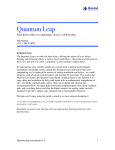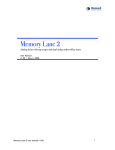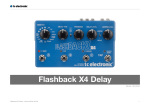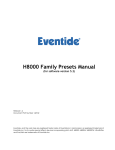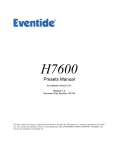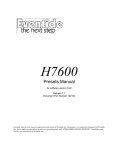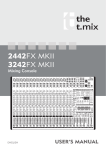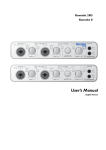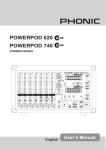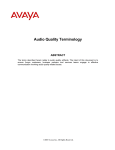Download ql manual v101 - Diamond Guitar Pedals
Transcript
Quantum Leap Short delay toolbox covering flange, chorus, to 600 ms delay User Manual v1.01 • August 9, 2012 Quantum Leap user manual v1.01 1 INTRODUCTION The Quantum Leap is a toolkit of short delays, offering the option of lo res delays, flanging and chorusing effects as well as fixed comb filters - effects that are both great on their own, and also as a useful ‘companion’ to other analog or digital delays. By utilizing the same variable sample rate concept used in analog bucket brigade modulation, and adding custom analog anti-aliasing and reconstruction filters and companding, we’ve captured the essence of analog modulation and delays... in a small footprint, with advanced control features, and standard 9V powering. First used in the Memory Lane Junior, the Quantum Leap digital sampling engine’s sole function is to copy, delay, and reproduce the delay path signal with no mathematical manipulation at all* - and unlike standard audio codecs, there are no digital anti-aliasing and reconstruction filters. All signal paths around the sampling engine (direct path, feedback path, and everything before and after the digital sampler) are analog, paths carefully designed to provide a unique sonic signature that is unmistakably Diamond. We hope you’ll enjoy using this pedal as much as we have enjoyed designing it. * well, almost no manipulation at all....in the QL’s Tap Delay mode there is a tiny bit of signal processing to get the delay ‘wash’ sound. Remember to protect your hearing and wear appropriate hearing protection when playing loud… FEATURES • short delay ‘toolkit’, with modes for flange, chorus, comb filtering, and delays up to 600 ms • multiple delay voicings, including a darker voiced delay, a unique harmonic delay, and foot controlled pitch / delay ramping • tap tempo for LFO speed on flange/chorus, and delay time for the tap delay mode • adjustable modulation depth on delays • analog signal paths surrounding a simple sample-delay-playout engine • user selectable True Bypass or Buffered with Delay Trails operation • premium audio components, including Panasonic capacitors and 0.5% resistors • bi-color LEDs provides visual indication of modes, LFO and delay times • TapView (TM) allows the player to visually see the tap tempo speed on the ON/OFF LED while tapping A NOTE ABOUT POWERING THE QUANTUM LEAP The Diamond Quantum Leap is designed to be powered from either a 9V battery*(included), standard 9V negative tip DC power adapter or from a multi pedal power supply. Current draw is rated at a maximum of 70mA. ! *Please note that battery life with a standard 9V is limited to approximately 2.5 hours. We recommend using a quality negative tip 9V power adapter designed for powering musical accessories or a 9V negative tip feed from a dedicated pedal power supply. Quantum Leap user manual v1.01 2 QUICK START GUIDE To get started quickly using the Quantum Leap, simply turn the unit on, bring SPEED, WIDTH, REGEN and MIX to roughly noon on the dial, then toggle the MODE switch to a desired flange, chorus, filter or delay effect. As SPEED, WIDTH, REGEN and MIX can be set to an almost infinite number of possibilities across the multiple modes, here are a few ‘preset’ ideas (knob numbers represent clock positions) to get started: Name Mode (TAP/FX LED color) SPEED WIDTH REGEN MIX Sparkle clean Flange (green / yellow) 11 AM 3 PM 11 AM 1 PM Throaty distortion (distortion pedal in front of QL) Flange (green / yellow) 12 noon 12 noon 12 noon 2 PM Chorus nirvana Chorus (green / red) 3 PM 5 PM 7 AM 1:30 PM 80’s dream Chorus (green / red) 1 PM 12 noon 10:30 AM 12 noon Slow 80’s Chorus (green / red) 9 AM 3 PM 9 AM 12 noon Faux Leslie Chorus (green / red) 7 AM 1:30 PM 7 AM 1 PM Distortion comb (put a distortion pedal in front of the QL) Filter (solid yellow) 9 AM N/A 12 noon 5 PM Standard QL delay Tap delay (flashing green) 3 PM 11 AM 12 noon 12 noon Ambient delay Pitch ramp delay (flashing red) 5 PM 10 AM 5 PM 12 noon Quantum Leap user manual v1.01 3 TRUE BYPASS OR DELAY TRAILS? The Quantum Leap ships with the pedal set for delay trails. When bypassed using the ON/OFF switch, the delay repeats will trail off naturally. Should you prefer to have the Quantum Leap operate in True Bypass mode, you will need to set the internal DIP switches as shown below: *Note that switch #1 is not related to the bypass setting but to the Kill-Dry mode noted below. USING A PARALLEL FX LOOP? If you plan on using the Quantum Leap in a parallel FX loop and would like to control the effect mix using your amp control, we recommend setting the Quantum Leap to ‘KillDry Mode’. In this mode, the pedal will output only the delays and not the dry signal. To select ‘Kill-Dry’simply set DIP switch 1 as shown below: Quantum Leap user manual v1.01 4 CONTROLS EXPLAINED The Quantum Leap packs a lot of different types of functionality into 5 major modes, each accessible by sequentially toggling through using the MODE toggle switch. The modes can be identified visually by the color of the right hand side TAP/FX LED. The following table briefly summarizes each mode and the purpose and function of user controls when in that mode. The modes will be discussed in further detail later in this section. Mode Flange TAP/FX LED ‘mode’ color Alternating SPEED LFO speed green/yellow Chorus Alternating LFO speed green/red Filter Tap delay WIDTH TAP/FX ON/OFF LED color Pitch modulation Tap for LFO speed, Green when width hold to change to 1/4 ON, red for 1/4 time time Pitch modulation Tap for LFO speed, Green when width hold to change to 1/4 ON, red for 1/4 time time Constant Hi-range comb Lo-range comb Toggle between hi- Green for hi- yellow filter frequency filter frequency range and lo-range range, red for filter settings lo-range Modulation Tap for delay time, Green when depth (controls hold for harmonic ON, red for harmonic interval mode harmonic Flashing Delay time green size in harmonic mode mode Pitch ramp Flashing red Delay time delay Modulation Hold to ramp pitch, Green when depth let go to halt ramping, ON, red for hold again to ramp pitch ramp back to original pitch (a quick tap will return immediately to original pitch) Quantum Leap user manual v1.01 5 MODE Switch This toggle switch allows you to toggle through the choice of 5 different operational modes. Each mode is indicated on the TAP/FX LED by a different color/color combination: Flange (alternating green / yellow)- The Quantum Leap Flange mode has a unique voicing that lends itself to both clean and distorted guitar inputs. In its regular mode of operation, the LFO is a sine wave with a speed range of approximately 6 Hz to 1.5 seconds/cycle. Both the SPEED and TAP/FX switch can be used to set the LFO rate. The LFO sweep width is set by the WIDTH control. REGEN can be used to control the amount of feedback ‘hollowness’. By holding down the TAP/FX switch, Flange enters a ‘1/4 time’ mode, where LFO speed is set to 1/4 the rate of whatever is set on the SPEED dial or tapped in. This allows for more accurate setting of very slow LFO speeds to a particular tempo. Also, for Flange in 1/4 time mode, the LFO shape is changed to a ‘shark-fin’ shape to give a more pronounced frequency rise and fall at its height. It’s still not the same as a true ‘through zero’ flange effect (which the Quantum Leap does not have support for), but with distortion in front of it it’s a nice effect on its own. For best Flange effects, keep the MIX knob up past 1 or 2 PM. With the shark fine LFO waveform, you may notice some slight ‘aliasing’ high frequency artifacts at the most extreme LFO WIDTH settings, this is normal operation. Chorus (alternating green / red)- The Chorus mode has considerable flexibility, with control over REGEN (feedback) and MIX as well as LFO rate (SPEED) and depth (WIDTH). Like the flange mode, both the SPEED and TAP/FX switch can be used to set the LFO rate. In regular Chorus mode, also like the Flange, the LFO speed can range from approx 6 Hz to 1.5 seconds/cycle, with TAP/FX held for ‘1/4’ time mode. Unlike the flange, the LFO waveform does not change when going to 1/4 time - it remains a sine wave. Filter (solid yellow)- a unique quasi-comb fixed filter, this is very useful for either pronounced fixed filtering of distorted guitar inputs, or to add more subtle character to clean guitar. The TAP/FX switch can be used to toggle back and forth between two different filter settings for creative emphasis during songs. In the default‘Green’ mode (ON/OFF LED is green), the comb frequencies are varied with the SPEED knob, and when switched to the the ‘Red’ mode (ON/OFF LED is red) using the TAP/FX footswitch, the comb frequencies are varied with the WIDTH knob. Each mode has different ranges - the ‘Green’ mode emphasizes higher frequencies and is more influenced by REGEN settings, while the ‘Red’ mode has a flatter overall response with less influence by REGEN settings. Tap delay (flashing green)- this max 600 ms tap delay mode at first glance appears to be the most similar to a standard ‘MLJr’ tap delay, but has two notable Quantum Leap user manual v1.01 6 differences. First, it’s repeats are significantly darker than the MLJr’s, using a combination of both slightly darker analog filtering as well as a unique ‘sample smear’ technique that smooths transients resulting in delay ‘washes’. Second, holding down the TAP/FX in this mode puts the Quantum Leap into an ‘out there’ harmonic delay mode, with either octave or fifth repeats selectable on the WIDTH knob. The Tap Delay mode also introduces ‘auto double time’ for tap, where delay times tapped in between 600 and 1200 ms automatically get mapped to half the delay time (between 300 and 600 ms). ***Additional notes on the harmonic delay mode - this is definitely one of the more ‘experimental’ modes on the Quantum Leap. The intervals are ‘stackable’ in that increasing REGEN increases the number of times the interval continues to go up in frequency (to the audible point of sampling rate limitations) - setting REGEN to min allows for just a single interval up. By controlling the amount of upward ‘spiral’, REGEN acts almost like a harmonic ‘tone control’... Also, play timing can be a bit strange in this mode, as the method used for generating the sped up repeats generates a two beat ‘gallop’ as the moving delay buffer is replayed, and this can arbitrarily affect the beginning and end of exact note phrases - all part of the harmonic delay mode ‘character’! The QL ships in ‘default octave’ mode - the WIDTH control will switch over to fifth intervals if you turn WIDTH almost completely clockwise, so for the majority of the range of WIDTH the harmonic interval will be an octave. To reverse this, and make the fifth the default for the majority of WIDTH, simply turn off the QL, and hold down the TAP/FX knob while the QL powers up. In this ‘default fifth‘ setting, octaves are now reached by turning WIDTH fully clockwise. So why this complexity? We wanted users to be able to try both octave and fifths easily, but also make sure that when switching into this mode from tap delay that except for the most extreme modulation settings used in the parent tapdelay mode, they would reach their desired default harmonic without needing to change the WIDTH knob. One final note: minimum delay times are limited in the harmonic mode - the QL will automatically increase the delay time in this mode if you’ve entered from a very short delay previously, then go back to the short delay upon returning to regular tap delay mode.. Even with the harmonic mode’s limitations, it’s possible to create unique tones ranging from far eastern note spirals to cool post-distortion fifth and octave effects. Let us know what you come up with! Pitch ramp delay (flashing red)- This delay mode has both a different tone voicing and feature set than the Tap Delay mode, although it remains 600 ms max delay time. Tonally, this does not use the delay ‘wash’ technique used for Tap Quantum Leap user manual v1.01 7 Delay, keeping transient definition in tact. Also, as opposed to Tap Delay whose repeats always eventually fade to zero even at max REGEN, Pitch Ramp Delay will achieve ‘Controlled Feedback Mode’ at maximum REGEN, basically repeating many times without oscillating. Pitch Ramp Delay uses the TAP/FX footswitch for a special function (which we’ll get to next), so delay time is set only via the SPEED knob. If you don’t need tap and don’t touch the TAP/FX switch, you basically have a nice clean delay mode available that’s similar to the tonality of the Memory Lane Jr’s 4th mode (the QL does have slightly darker analog filtering and a slightly different voiced modulation relative to the MLJr). On to the Pitch ramping function... in this mode, the TAP/FX switch allows you to ramp the delay time by holding it down...then return it to the original delay time by letting the switch go, then holding the TAP/FX switch down again. Let’s dive in with a little more detail - once you get the hang of its operation, it’s very straightforward and stage friendly. First, the initial direction of the pitch ramping (up or down) depends on which side of ‘noon’ the SPEED dial is set. If you’re on the PM side, pitch ramping first goes up (to a shorter delay time), and if you’re on the AM side, pitch ramping first goes down (to a longer delay time). If you keep holding the switch down it will ramp to one octave difference (1/2 or double delay time), then hold at that delay time. If you let go of the TAP/FX switch at any point on that initial ramp (or after it has reached the octave point), it will hold at that delay time. Pressing down the TAP/FX switch again begins the return to the original delay time on the SPEED knob which it will continue as long as you hold the switch until it reaches the original delay time - but letting go of the TAP/FX switch early will drop you immediately to the original delay time (so a quick jab of the TAP/FX switch after you’ve reached your desired ramp delay time will bring you immediately back to the original delay time). Take some time to play around with this - bring the REGEN up fairly high so the pitch changes strongly affect the built up delays, and with a little practice you can time the footswitch holds to change the delay time to almost any desired semitone within the octave range. The ON/OFF LED is used to provide visual feedback of where you are in the ramping process. If you’re in the process of ramping from ‘ground zero’, or are holding at a new delay time after releasing the TAP/FX footswitch after the initial ramp, the LED will be red, and if you’re returning to, or already at the ‘ground zero’ delay time, the LED will be green. With the feedback (REGEN) up, you can achieve some very interesting effects, from ‘turntable’-like speed change ‘bumps’ to almost ‘whammy’ like dives by setting the initial SPEED before noon with a distortion pedal out in front of the QL. Quantum Leap user manual v1.01 8 SPEED In the Flange and Chorus modes, the SPEED knob controls the speed of the modulation LFO. In the delay modes, it controls the delay times. In Flange and Chorus, the LFO speed can also be set using the TAP/DBL footswitch, and in Tap Delay mode the delay time likewise - you can seamless go back and forth between knob or footswitch control just by using one or the other. In the Filter mode, the SPEED knob controls the frequency of the first (higher frequency range) filter. WIDTH In the Flange and Chorus modes, the WIDTH knob sets the sweep range of the LFO, while in the delay modes it controls the depth of the fixed rate modulation function. Turning the control clockwise will increase the modulation effect, while turning this control to minimum will disable the modulation. In the Filter mode, the WIDTH knob controls the frequency of the second (lower frequency range) filter. REGEN The REGEN knob determines the amount of signal fed back from the output of the effect to its input. For Flange and Chorus, this can drastically affect the ‘hollowness’ of the effect, while in the delay modes it controls the number of repeats that will result from a played note or chord. Turning this control clockwise increases the number of feedback / repeats. Setting this control to minimum will result in zero feedback (and a single repeat in delay modes). MIX The MIX knob determines the amount of effect signal to be added to the direct signal path, ranging from none at counterclockwise, to a few dB louder than the direct signal at full clockwise. TAP/FX The TAP/FX footswitch provides two primary functions - either for tapping in LFO speeds or delay times, or for accessing other special ‘FX’ functions (either directly, or by holding the switch down until an alternate mode is entered). As the function of this switch is dependent on the effect mode, please see earlier descriptions of the modes and their constituent functions for a full explanation of TAP/FX switch control functionality. Quantum Leap user manual v1.01 9 ADDITIONAL FEATURE NOTES TAP VIEW As with the Tremolo and Memory Lane Jr, the Quantum Leap provides TapView (TM) for temporary visual indication of tap tempo settings on the ON/OFF LED while tapping the TAP/FX footswitch and obstructing the usual tempo indication TAP/FX LED. LOW BATTERY INDICATOR Upon detection of low battery levels, the Quantum Leap will set both LED’s to solid yellow. MODE POWER OFF SAVE The current mode (Flange, Chorus, Filter, Tap Delay or Pitch Ramp Delay) is saved to flash memory whenever changed by the MODE toggle, and will start up in the last used mode on power up. BETWEEN-MODE SETTING SAVES As you toggle between modes, tap LFO rates / tap delay times / special function settings (1/4 time mode etc) are saved for that mode, and reloaded when toggled back to that mode. On power off however, only the MODE itself is saved in flash memory, not associated delay times etc. WARRANTY Your Diamond pedal is covered by a 5 year warranty on materials and workmanship. Please contact us by telephone (902-832-7139) or email [email protected] if you experience any problems with your pedal. We’re here to help! Quantum Leap user manual v1.01 10










